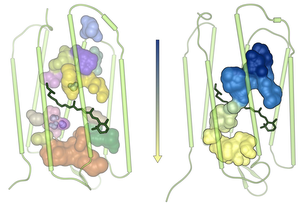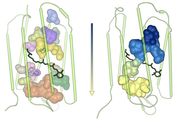Information
- Publication Type: Journal Paper with Conference Talk
- Workgroup(s)/Project(s):
- Date: 2016
- Journal: Computer Graphics Forum
- Volume: 35
- Number: 3
- Location: Gronningen, The Netherlands
- Lecturer: Michael Krone
- Pages: 527 – 551
Abstract
In this report we review and structure the branch of molecular visualization that is concerned with the visual analysis of cavities in macromolecular protein structures. First the necessary background, the domain terminology, and the goals of analytical reasoning are introduced. Based on a comprehensive collection of relevant research works, we present a novel classification for cavity detection approaches and structure them into four distinct classes: grid-based, Voronoi-based, surface-based, and probe-based methods. The subclasses are then formed by their combinations. We match these approaches with corresponding visualization technologies starting with direct 3D visualization, followed with non-spatial visualization techniques that for example abstract the interactions between structures into a relational graph, straighten the cavity of interest to see its profile in one view, or aggregate the time sequence into a single contour plot. We also discuss the current state of methods for the visual analysis of cavities in dynamic data such as molecular dynamics simulations. Finally, we give an overview of the most common tools that are actively developed and used in the structural biology and biochemistry research. Our report is concluded by an outlook on future challenges in the field.Additional Files and Images
Weblinks
BibTeX
@article{Krone2016VABC,
title = "Visual Analysis of Biomolecular Cavities: State of the Art",
author = "Michael Krone and Barbora Kozlikova and Norbert Lindow and
Marc Baaden and Daniel Baum and Julius Parulek and
Hans-Christian Hege and Ivan Viola",
year = "2016",
abstract = "In this report we review and structure the branch of
molecular visualization that is concerned with the visual
analysis of cavities in macromolecular protein structures.
First the necessary background, the domain terminology, and
the goals of analytical reasoning are introduced. Based on a
comprehensive collection of relevant research works, we
present a novel classification for cavity detection
approaches and structure them into four distinct classes:
grid-based, Voronoi-based, surface-based, and probe-based
methods. The subclasses are then formed by their
combinations. We match these approaches with corresponding
visualization technologies starting with direct 3D
visualization, followed with non-spatial visualization
techniques that for example abstract the interactions
between structures into a relational graph, straighten the
cavity of interest to see its profile in one view, or
aggregate the time sequence into a single contour plot. We
also discuss the current state of methods for the visual
analysis of cavities in dynamic data such as molecular
dynamics simulations. Finally, we give an overview of the
most common tools that are actively developed and used in
the structural biology and biochemistry research. Our report
is concluded by an outlook on future challenges in the
field.",
journal = "Computer Graphics Forum",
volume = "35",
number = "3",
pages = "527--551",
URL = "https://www.cg.tuwien.ac.at/research/publications/2016/Krone2016VABC/",
}


 paper
paper
